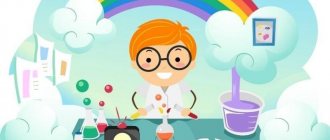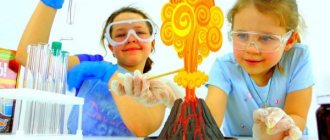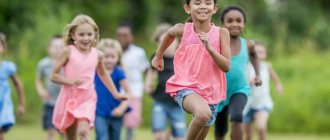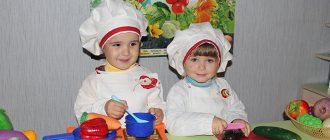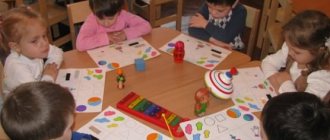Experimental lesson in kindergarten
An experimental lesson in kindergarten is structured taking into account the age characteristics of children and in the first junior group, according to SANPiN standards, lasts no more than 15 minutes. To prevent overwork, various forms of activity are used: gaming (didactic games, activities with toys), physical (physical education, outdoor games, finger exercises), entertaining (singing, learning rhymes and sayings), cognitive (studying visual material, holding a conversation).
The experimental lesson consists of the following structural elements:
- organizational moment - 1 minute,
- motivating start of the lesson - 4 minutes,
- play or physical activity - 4–5 minutes,
- practical activity - 4–5 minutes,
- summing up - 1 minute.
After the experiment, the students help tidy up the workplace or demonstration table and put away the tools.
A reflection stage is required at the end of the lesson: the guys share their emotions from the discovery process and tell what they liked about the lesson.
Experimental activities should evoke positive emotions, which the children share with each other at the end of the lesson
Card index of experiences and experiments in the first junior group - table
| Subjects | Contents of experiments and tests |
| "Water (liquid form)" |
|
| "Solid forms of water: ice and snow" |
|
| "Sand" |
|
| "Paper" |
|
| "Textile" |
|
| "Light" |
|
| "Air" |
|
| "Magnet" |
|
Pupils of the first junior group try to draw with a trickle of sand
Summary of the ECD (experimental activity) lesson in the first junior group “Stone and wood. Properties of objects" - table
| Program content |
|
| Materials and equipment |
|
| Progress of the lesson | - Guys, today we have an interesting and exciting task ahead of us. Look at the pictures. (Shows trees and wooden objects.) What are they depicting? You and I already know that many different objects can be made from wood: houses, paper, furniture, and toys. Now let's remember what kind of stones there are and what people make from stone. (Shows pictures, children’s answers.) Physical exercise - Today, guys, I brought you wooden balls and sea pebbles. Touch them, compare. They are round in shape and identical in weight. Roll them in your hands, how do you feel? (The children concluded that wooden balls are warmer than pebbles, heavier, harder.) - Why do you think I brought a basin of water to the group? (Answers.) - Do you think the stone will float on the surface? And the tree? What will drown? (Answers.) - Now let’s see everything for ourselves. (Children take turns throwing wooden balls into the water, then pebbles.) - So, guys, we saw that all the balls float on the surface, which means they are lighter than the stones that sank. Even a small pebble is heavier than a large wooden object. Reflection stage. Children share their emotions from experimentation. |
